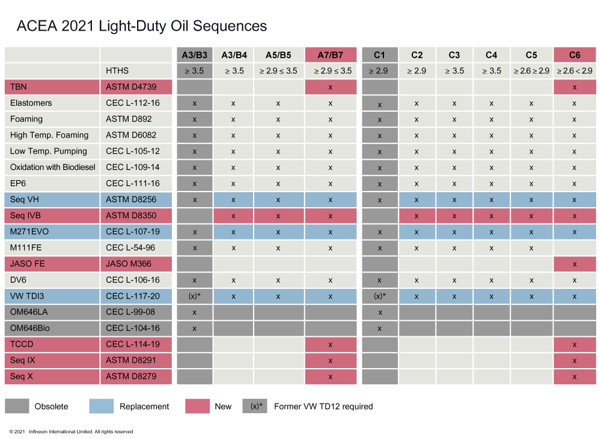Passenger cars
Severe hybrid engine oil testing
20 May 2025
25 May 2021
New European Oil Sequences for light-duty engines issued

The new ACEA European Oil Sequences for light-duty engines were issued on April 30 2021 in order to address engine developments that are being driven by both regulatory and performance needs, complemented by necessary test maintenance requirements. Uwe Zimmer, Infineum Industry Liaison Advisor, reports on the outcome and reflects on the long journey from the ACEA 2016 Sequences to this latest release of the 2021 ACEA light-duty Sequences.
It is not surprising that many of the expected changes Insight reported in February can now be confirmed. This comprehensive wrap-up on the 2021 ACEA European Oil Sequences for light-duty (LD) engines, while not repeating too much of what has been reported previously on motivations and drivers, will focus on the outcomes. However, before we dive into the light-duty topics, let’s briefly talk about a change in the document management of the ACEA Engine Oil Sequences.
Until recently the release timings of the ACEA LD and heavy-duty (HD) Engine Oil Sequences were concurrent, which allowed ACEA to have one file specifying the requirements for LD and HD (e.g. the 2016 ACEA Oil Sequences). This file not only specified the performance requirements but also the conditions for use of ACEA performance claims, the certification and registration process, the nomenclature, and the consumer language.
However, since the timing for the 2021 ACEA LD and HD Sequences has diverged, ACEA has chosen to have a General Requirements document common to ACEA LD and HD. This document details the conditions for use of ACEA performance claims, the certification and registration process, and the nomenclature, supplemented by dedicated documents for LD and HD detailing the technical requirements. This action explains why ACEA has reissued the 2016 Heavy-Duty Engine Oil Sequences in the new format, with all requirements remaining unchanged.
Essentially the general requirements remained unchanged, with the European Engine Lubricants Quality Management System (EELQMS available here), defining the compliance process. Only oil marketers who have signed the EELQMS oil marketers’ Letter of Conformance (click here for details) are allowed to make claims against the ACEA Oil Sequences.
Here it is worthwhile to note that the mandatory requirement for signing the EELQMS oil marketers’ Letter of Conformance should not be confused with the registration of products in the ACEA Registration System on the ACEA website. The latter, although highly welcomed by ACEA, is voluntary.
As anticipated, the 2021 ACEA European Oil Sequences for light-duty engines were released in April 2021 with a first allowable use on May 1 2021 before they become mandatory for new claims on May 1 2022.
As we had expected there was an unprecedented degree of change, which we will go on to explore.

Here is a round up of some of the key changes:
Some of the new tests are ASTM tests ‘borrowed’ from the North American API Engine Oil Specifications, the new fuel economy test comes from the Japanese JASO specification and the Coordinating European Council, CEC, also contributed new and replacement tests. The ACEA sequences are clearly going global.
Beside some significant maintenance activities, the legacy categories, A3/B4, A5/B5 and C2 to C5, remained as they are.
The Sequence VH at API SP limits replaces the Sequence VG at API SM limits as the low temperature sludge test and the M271Evo (CEC L-107) replaces the Daimler M271 as the black sludge test. Both new tests come with a footnote detailing the conditions for using the predecessor test results to demonstrate compliance with ACEA 2021 requirements. In simplified terms the concept of using data from predecessor tests in lieu of performance proof on the same parameter in the new test is known as ‘grandfathering’.
The VW TDI3 (CEC L-117) replaces the current TDI test. Equal severity was targeted but difficult to define based on the available data. The limits set are thus the best compromise the industry could find after long, intense, and constructive discussions. Again, the test comes with a footnote detailing the grandfathering requirements.
The Sequence IVB stands out as it is not meant to be a direct successor of any particular test but rather to fill the gap the TU3 left behind half a decade ago for a gasoline valvetrain wear test. Finding suitable limits was a difficult task, on one hand 50% of the ACEA lubricants tested failed to meet the initially proposed limits while, on the other, these products have been in the field without causing wear issues. It was agreed to introduce tiered limits for the Sequence IVB, with the API SP limits applying to the new ACEA categories only, while for legacy categories the limits are less severe and more appropriate for existing European products within those categories. Additionally, to mitigate the impact on current ACEA lubricants, the Sequence IVB comes with a footnote allowing the Sequence IVA as an alternative to the Sequence IVB for the legacy categories.
The OM646LA and OM646Bio tests have been removed from the ACEA 2021 Light-Duty Oil Sequences. This was due to limited hardware availability, as the lifetime of these tests was not guaranteed beyond the end of 2022. Yet again, a very difficult decision to take but, in the absence of successor tests, there was not much choice.
In summary, we are seeing significant changes in the legacy categories, which may have wide reaching implications on the current ACEA lubricant portfolio. Mitigating the impact and maintaining the integrity of the sequences is the common objective AAA (ACEA, ATIEL and ATC) has worked towards.
There are two new categories that introduce the long-awaited low-speed pre-ignition (LSPI) performance as a key feature.
A7/B7 is a new category building on A5/B5. The new features are protection against LSPI, a chain wear requirement to address wear concerns with gasoline direct injected engines and finally an all-new turbocharger compressor cleanliness requirement as a preventative measure.
C6 is the corresponding reduced SAPS category, built on C5, adding the same engine performance features as A7/B7, but on top of it a new fuel economy test.
In our view, C6 is the most important new ACEA category as it combines additional engine performance, in particular LSPI performance, reduced SAPS for aftertreatment compatibility and SAE xW-20 viscosity for high fuel economy potential.
All changes discussed for the legacy categories are also applicable to the new categories, with tighter Sequence IVB limits relative to legacy categories and restrictions on M271Evo grandfathering.
Further to the engine test requirements, the new categories also introduce a new TBN specification via ASTM D4739. The topic caused controversy, not at least as ASTM D4739 explicitly states that it is not a recommendable method for setting a fresh oil TBN specification and ASTM D2896 provides much better precision. While the limits now defined seem attainable, it is not clear why ACEA introduced this parameter and what failure mode it is meant to protect against.
On the positive side, there has been consensus among the stakeholders about the introduction of the new engine performance requirements and the new categories. An earlier Insight article here provides more details about the new tests.
Discussing limits on a test by test basis is already a complex task. However, discussing requirements in the full context of the ACEA categories is significantly more complex due to the trade-offs between requirements.
If that were not complex enough, the OEM specification-driven European market also requires these ACEA baseline requirements to be compatible with the OEM specification requirements and the economic environment. Until the discussion about the 2021 sequences requirements had matured in the beginning of 2021, there was a ‘chicken and egg’ dilemma preventing the definition and testing of candidate oils in the full sequence context.
However, in recent months, there was a consolidated industry effort to do exactly this. ATIEL sponsored testing, ATC contributed significant data and ACEA carried out internal testing. Once the data were available, they were discussed among the stakeholders.
From an Infineum perspective these were very constructive and fruitful discussions, highlighting the value of stakeholder consultations.
With overall good consensus on the technical requirements the remaining job was to get things in writing. Once again, there was good collaboration between ACEA, ATIEL and ATC (AAA) to produce the final sequence documents just in time for the April 30 release.
In addition to the General Requirements, the ACEA Oil Sequences 2021 for light-duty engines document now comes with a table specifying validity of editions of the ACEA Light-Duty Oil Sequences, a revised consumer language and, of course, the detailed technical requirements.
On reflection it has been a long journey from the release of the ACEA 2016 Sequences to the release of the 2021 ACEA Light-Duty Sequences, with some heated debates but mostly constructive and results-oriented discussions. Ultimately all stakeholders had a common objective of meaningful, fit for purpose ACEA specifications defining the baseline requirements. This outcome has been highly successful.
The test limits for the new categories set a challenging baseline in some instances, but the final ACEA 2021 limits appear achievable and realistic without compromising OEM or economic requirements.
Infineum aims to offer ACEA 2021 capable products shortly, including products meeting the new ACEA A7/B7 and C6 categories. In addition, we are busy producing the Infineum ACEA 2021 brochure, which will be available shortly. At the same time, we will continue to monitor and contribute to ACEA Sequence developments and will keep you posted on the developments on the ACEA heavy-duty specifications.
Sign up to receive monthly updates via email